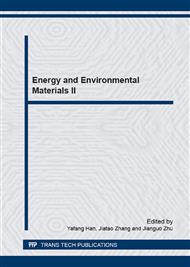[1]
Information on http: /www. miit. gov. cn/n11293472/n11293832/n15216906/n15217022/15272238. html.
Google Scholar
[2]
Helmers E, Marx P, Electric cars: technical characteristics and environmental impacts. Environmental Sciences Europe (2012).
DOI: 10.1186/2190-4715-24-14
Google Scholar
[3]
Notter D A, Gauch M, Widmer R, et al, Contribution of Li-ion batteries to the environmental impact of electric vehicles, Environmental science & technology (2010).
DOI: 10.1021/es903729a
Google Scholar
[4]
Hawkins T R, Gausen O M, Strømman A H, Environmental impacts of hybrid and electric vehicles—a review, The International Journal of Life Cycle Assessment (2012).
DOI: 10.1007/s11367-012-0440-9
Google Scholar
[5]
Frischknecht R, Flury K, Life Cycle Assessment of Electric Mobility: Answers and Challenges, The International Journal of Life Cycle Assessment, (Zurich, 2011).
DOI: 10.1007/s11367-011-0306-6
Google Scholar
[6]
L. Zhang, Life Cycle Assessment of Electric Vehicle Based on GaBi4. (Hefei University of Technology, Hefei 2011).
Google Scholar
[7]
H. Liu, H.W. Wang, Q. Luo, Energy, Environment and Economic Assessment of Life Cycle for Electric Vehicle, Technology & Economy in Areas of Communications (2008).
Google Scholar
[8]
Z.Y. Hu, P. Cheng, P.Q. Tan, Life Cycle Assessment of Electric Vehicle, CSES Vol. 8 (2013).
Google Scholar
[9]
Ou X, Yan X, Zhang X, et al, Life-cycle analysis on energy consumption and GHG emission intensities of alternative vehicle fuels in China, Applied Energy (2012).
DOI: 10.1016/j.apenergy.2011.03.032
Google Scholar
[10]
X.M. Ou, X.L. Zhang, Y.N. Qin, Life Cycle Analysis of Electric Vehicle Charged by Advanced Technologies Coal-power in Future China, Journal of China Coal Society, Vol. 35 (2010).
Google Scholar
[11]
X.M. Ou, X.L. Zhang, Life-cycle Analysis of Automotive Energy Pathways in China (Tsinghua University Press, Beijing 2008).
Google Scholar
[12]
ISO14040, Environmental Management–Life Cycle Assessment–Principles and Framework: (British Standards Institution, London 2006).
Google Scholar
[13]
M.A. Gurran, Environmental Life-Cycle Assessment (McGraw-Hill Companies, Inc., USA (1996).
Google Scholar
[14]
Goran Finnveden, Michael Z. Hauschild b, Tomas Ekvall c, Recent developments in Life Cycle Assessment, Journal of Environmental Management (2009).
Google Scholar
[15]
C. Wang, K.W. You, W.X. Shen, Comprehensive Evaluation on Vehicles Ecological Design and Cost Evaluation, Energy-saving and new energy vehicle yearbook (Economic PressŸ China, Beijing 2013).
Google Scholar
[16]
Information on https: /greet. es. anl. gov.
Google Scholar
[17]
Change IPOC, 2006 IPCC Guidelines for National Greenhouse Gas Inventories. (Institute for Global Environmental Strategies, Hayama, Kanagawa, Japan, 2006).
Google Scholar
[18]
Dunn J B, Gaines L, Barnes M, et al, Material and energy flows in the materials production, assembly, and end-of-life stages of the automotive lithium-ion battery life cycle, Argonne National Laboratory (ANL) (2012).
DOI: 10.2172/1044525
Google Scholar
[19]
Majeau-Bettez G, Hawkins T R, Strømman A H, Life cycle environmental assessment of lithium-ion and nickel metal hydride batteries for plug-in hybrid and battery electric vehicles, Environmental science & technology (2011).
DOI: 10.1021/es2015082
Google Scholar
[20]
H.M. Zhou, Life Cycle Assessment of Iron and Steel Processes, (Beijing University of Technology, Beijing 2001).
Google Scholar
[21]
J.L. Jiang, J.F. Dai, W.J. Feng, J.C. Xu, Life Cycle Assessment of Metallic Copper Produced by the Pyrometallurgical and Hydrometallurgical Processes, Journal of Lanzhou University of Technology Vol. 32 (2006).
Google Scholar
[22]
R.M. Ruan, S.P. Zhong, D.Z. Wang, Life Cycle Assessment of Two Copper Metallurgical Process: Bio-heap Leaching and Flotation-Flash Smelting, Multipurpose Utilization of Mineral Resources (2010).
Google Scholar
[23]
N. Ding, F. Gao, Z.H. Wang, Comparative Analysis of Primary Aluminum and Recycled Aluminum on Energy Consumption and Greenhouse Gas Emission, The Chinese Journal of Nonferrous Metals (2012).
Google Scholar
[24]
N. Ding, Life Cycle Assessment of Typical Aluminum Alloys, (Beijing University of Technology, Beijing 2012).
Google Scholar
[25]
W.X. Shen, Life Cycle Assessment of Magnesium Alloy, (Beijing University of Technology, Beijing 2011).
Google Scholar
[26]
B.R. Yuan, Z.R. Nie, X.H. Di, Life Cycle Assessment of Ethylene Production (Ⅰ)Goal and Scope Definition and Inventory Analysis, Chemical Industry and Engineering Progress (2006).
Google Scholar
[27]
X.C. Wang, K.W. You, C. Wang, Environmental Impact Analysis of Electric Vehicle Battery Manufacturing and Recycling Stage, Energy-saving and new energy vehicle yearbook (Economic Press China, Beijing 2013).
Google Scholar
[28]
X.H. Di, Z.R. Nie, T.Y. Zuo, Life Cycle Inventory for electricity industry in China, The International Journal of Life Cycle Assessment (2006).
Google Scholar
[29]
B.R. Yuan, Z.R. Nie, X.H. Di, Life Cycle Inventories of fossil fuels in China (Ⅱ):Final Life Cycle Inventories, Modern Chemical Industry (2006).
Google Scholar
[30]
S.Q. Zhong, Automotive Manufacturing Engineering, (South China University of Technology press, Fuangzhou 2011).
Google Scholar
[31]
J.L. Jiang, J.C. Xu, Y.Q. Wu, Life Cycle Assessment study of Secondary Copper, Journal of Lanzhou University of Technology Vol. 32 (2006).
Google Scholar


